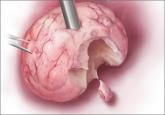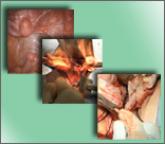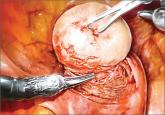From the Editor

Benefits and pitfalls of open power morcellation of uterine fibroids
The current practice of open power morcellation is being scrutinized by those within and outside of the ObGyn community. We need to re-examine our...
Robert L. Barbieri, MD
Editor in Chief
Chair, Obstetrics and Gynecology, Brigham and Women’s Hospital, Boston, Massachusetts; Kate Macy Ladd Professor of Obstetrics, Gynecology and Reproductive Biology, Harvard Medical School, Boston
rbarbieri@frontlinemedcom.com
Dr. Barbieri reports no financial relationships relevant to this article.

The most promising alternative to open power morcellation is morcellation in a bag, described here
Morcellation in the News
- Philadelphia hospital restricts 'morcellation' procedure Wall Street Journal, February 20, 2014
- Society of Gynecologic Surgeons releases position statement on morcellation
- Uterine surgical technique is linked to abnormal growths and cancer spread New York Times, February 6, 2014
- Evaluating the risks of electric uterine morcellation JAMA, February 6, 2014. doi:10.1001/jama.2014.1093
- Critics of fibroid removal procedure question risks it may pose for women with undetected uterine cancer JAMA, February 6, 2014. doi:10.001/jama.2014.27
Open power morcellation of the uterus and uterine tumors has the advantage of permitting the removal of large tissue masses through small laparoscopic incisions. The advantages of using laparoscopic approaches compared to laparotomy to treat uterine tumors include: lower risk of surgical site infection, less blood loss, less postoperative pain, and more rapid return to full activities.1 However, when used to treat tumors presumed to be fibroids, open power morcellation is associated with an increased risk of dispersing benign myoma tissue and occult malignant leiomyosarcoma tissue throughout the abdominal cavity.2–5 Dispersion of benign myoma tissue may result in the growth of fibroids on the peritoneal surface, omentum, and bowel, causing abdominal and pelvic pain and necessitating reoperation. Dispersion of leiomyosarcoma tissue throughout the abdominal cavity may result in a Stage I cancer being upstaged to a Stage IV malignancy, requiring additional surgery and chemotherapy.6 In cases in which open power morcellation causes the upstaging of a leiomyosarcoma, the death rate is increased.7
Related Articles:
Benefits and pitfalls of open power morcellation of uterine fibroids Robert L. Barbieri, MD (Editorial, February 2014)
How I avoid open power morcellation (Comment & Controversy, March 2014)
Gynecologic surgeons should strive, when possible, to reduce the use of open power morcellation in the treatment of large uterine tumors believed to be fibroids. The most promising alternative to open power morcellation is morcellation in a bag.
POWER MORCELLATION IN A BAG
Dr. K. Anthony Shibley has reported a novel technique for the use of power morcellation within an insufflated Lahey bag (VIDEO 1). The Lahey bag (Becton Dickinson, Franklin Lakes, New Jersey) is also known as an “isolation” or “turkey” bag. The Lahey bag is 45 cm by 45 cm, and sufficiently large to hold most uterine tumors.
![]()
![]()
The Shibley technique involves rolling up the Lahey bag, inserting the bag through an open single port cannula, recapping the cannula, inserting the tumor in the bag, opening the port to bring the opening of the bag up through the port, recapping the port cannula, insufflating the bag and performing power morcellation within the bag. Power morcellation in a bag reduces the risk of spreading bits of the tumor throughout the abdominal cavity.
MANUAL MORCELLATION IN A BAG
Serur and Lakhi8 reported a technique for laparoscopic hysterectomy that involves using laparoscopic techniques to separate the uterus from vascular and supporting structures followed by manual morcellation in a bag. In this technique, once the uterus is separated from its vascular and supporting structures, an Endo Catch II 15-mm polyurethane specimen pouch (Covidien Surgical, Mansfield, Massachusetts) is inserted through an abdominal port. The bag is opened and the uterus is placed into the specimen bag with graspers.
The authors report that the 15-mm bag can accommodate tumors as large as a 22-week size uterus. An abdominal port incision is then enlarged to 20 mm to 30 mm so that the opening edge of the bag can be brought out through the incision to the skin surface. Lahey clamps are used to hold the uterus against the abdominal wall while it is circumferentially cored with a scalpel. The manual morcellation is performed within the bag, reducing the risk of spilling tumor cells into the pelvic and abdominal cavity.
Favero and colleagues9 have reported an alternative approach that involves bringing the opening of the bag out through the vagina and performing hand morcellation of the tumor in the bag via the vagina. Following laparoscopic hysterectomy, a 5 inch by 8 inch (12.7 cm by 20.3 cm) or 8 inch by 10 inch (20.3 cm by 25.4 cm) polyurethane bag with polypropylene draw strings (Lapsac, Cook Medical, Bloomington, Indiana) is inserted into the abdominal cavity through the vagina. The uterus is inserted into the bag and the drawstrings are pulled to close the bag.
The authors emphasize that the uterine fundus must be positioned in the bottom of the bag and the cervix must be oriented toward the opening of the bag. This will facilitate the entry of the uterus into the vaginal vault and permit the vaginal morcellation step to be performed as close as possible to the vaginal introitus. The drawstrings are then inserted into the vaginal apex and the surgeon pulls the strings and opening of the bag out to the vaginal introitus.

The current practice of open power morcellation is being scrutinized by those within and outside of the ObGyn community. We need to re-examine our...

Three intraoperative videos show surgical techniques from Javier F. Magrina, MD, and John B. Gebhart, MD, regarding morcellomas, and the vaginal...
New data and the guidance of our professional societies are bringing us closer to clarity in understanding the superiority of minimally invasive...

With robotic assistance, a surgeon can reduce blood loss, shorten hospitalization, and ease laparoscopic suturing and knot-tying—but myomectomy is...
This technique is K. Anthony Shibley, MD's, short-term surgical solution to performing closed power morcellation. His patented pneumoperitoneum...

Perform morcellation through a 5-mm laparoscope with the robot undocked, using the camera port site for morcellation.
The multiple advantages a laparoscopic approach to myomectomy can offer over laparotomy hinge on surgical technique—from preoperative evaluation...
